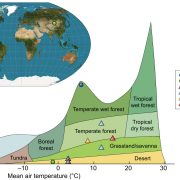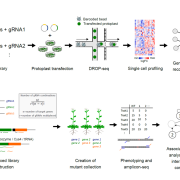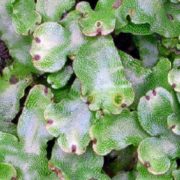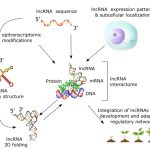Review: Transposable element life cycles in plant genomes and beyond
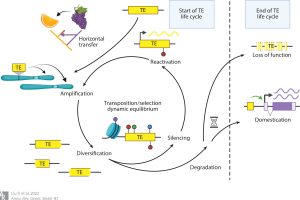 What a wonderful review! As the title indicates, this review by Liu et al. looks at transposons, considering their “life cycle” – from introduction into a naïve genome, through amplification, diversification, silencing, reactivation, and ultimately domestication or loss-of-function. Besides this thorough-but-readable walk through the transposon life cycle, the review also takes a pan-organismal look at transposons and their regulators, with strong representation from the plant kingdom. There’s also a discussion about how various transposon families got their names (interesting!) and efforts to both standardize them and eliminate names with derogatory origins. The final two sections were to me the most interesting. First, how TEs are “tamed” by reuse and domestication; TEs can be repurposed by incorporation into new genes, new regulatory elements, or telomeres. And finally, human interactions with TEs, which have advanced our understanding of evolution and adaptation; TEs were responsible for Mendel’s wrinkled peas, and the emergence of dark moths during the sooty coal-fueled industrial revolution. Furthermore, TEs have contributed to the genetic diversity in crop breeding and, in news to me, the diversification of dog breeds. Woof! (Summary by Mary Williams @PlantTeaching) Annu. Rev. Genetics 10.1146/annurev-genet-072920-015534
What a wonderful review! As the title indicates, this review by Liu et al. looks at transposons, considering their “life cycle” – from introduction into a naïve genome, through amplification, diversification, silencing, reactivation, and ultimately domestication or loss-of-function. Besides this thorough-but-readable walk through the transposon life cycle, the review also takes a pan-organismal look at transposons and their regulators, with strong representation from the plant kingdom. There’s also a discussion about how various transposon families got their names (interesting!) and efforts to both standardize them and eliminate names with derogatory origins. The final two sections were to me the most interesting. First, how TEs are “tamed” by reuse and domestication; TEs can be repurposed by incorporation into new genes, new regulatory elements, or telomeres. And finally, human interactions with TEs, which have advanced our understanding of evolution and adaptation; TEs were responsible for Mendel’s wrinkled peas, and the emergence of dark moths during the sooty coal-fueled industrial revolution. Furthermore, TEs have contributed to the genetic diversity in crop breeding and, in news to me, the diversification of dog breeds. Woof! (Summary by Mary Williams @PlantTeaching) Annu. Rev. Genetics 10.1146/annurev-genet-072920-015534


